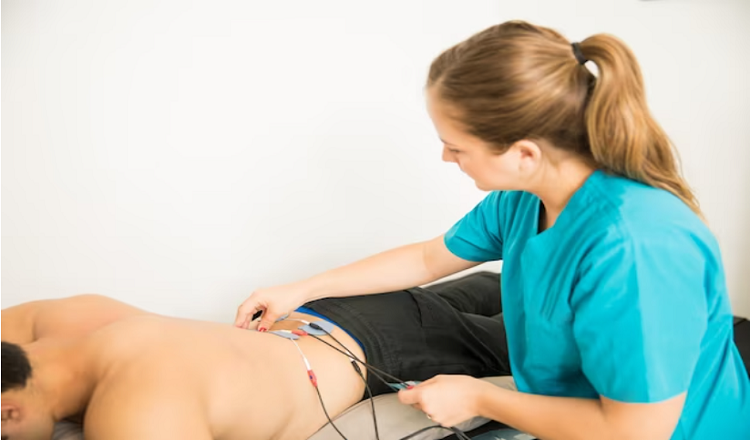
Are you sick of taking medicines each time you have a little bit of pain? Looking for a non-invasive remedy that won’t make you feel sleepy? You might find the solution you’ve been looking for in electrotherapy!
The use of electrotherapy as a secure and reliable pain management method has grown in popularity in the USA in recent years. This method includes stimulating the body’s nerves and muscles with electrical impulses. It can help treat a range of pain conditions, including musculoskeletal pain, acute pain, and chronic pain. Many people seeking a more natural remedy find electrotherapy to be an appealing option because it is a non-invasive and drug-free pain treatment approach.
We will examine what electrotherapy is, how it functions, as well as various methods and equipment used in electrotherapy in this in-depth guide on electrotherapy for pain relief. Additionally, we’ll go over safety measures, potential advantages of electrotherapy, and offer suggestions for some of the best electrotherapy equipment on the market in the USA. So settle back, unwind, and get ready to discover everything there is to know about this novel and fascinating pain management method.
Electrotherapy: What is it?
In the therapeutic process known as electrotherapy, electrical impulses are used to activate the nerves and muscles of the body. The fundamental idea underlying electrotherapy is that by altering how the body interprets pain signals, electrical stimulation might help lessen pain and inflammation.
TENS (transcutaneous electrical nerve stimulation), Interferential Therapy, Pulsed Electromagnetic Field Therapy, and Microcurrent Therapy are a few of the electrotherapy device types that are used to treat pain. The most popular type of electrotherapy device uses TENS technology to deliver electrical impulses to the nerves through the skin. TENS-like interferential therapy involves two or more electrical currents that are just out of phase with one another. Microcurrent Therapy uses low-level electrical currents to promote healing and pain alleviation whereas Pulsed Electromagnetic Field Therapy uses magnetic fields to activate the body’s cells. Each type of electrotherapy device has special advantages and can be used to treat pain in various ways.
How Does Pain Relief with Electrotherapy Work?
The way that electrotherapy works is by using electrical impulses to block the pain signals that are delivered from the body to the brain. An electrical impulse that is administered to the body travels via the nerves and triggers the release of endorphins, which are natural painkillers. This aids in reducing swelling and pain in the affected area.
Different types of pain, including musculoskeletal pain, acute pain, and chronic pain, can be treated using electrotherapy. Acute pain is immediate and usually goes away quickly, whereas chronic pain persists for longer than three months. Muscle, bone, and joint pain are collectively referred to as musculoskeletal pain. All of these types of pain can be successfully treated with electrotherapy thanks to its ability to reduce inflammation, encourage healing, and relieve pain. The condition of the patient and the location of the body being treated will determine the precise type of electrotherapy performed.
Methods of Electrotherapy for Pain Relief
There are various electrotherapy methods available for pain management, each with special advantages. TENS, also known as transcutaneous electrical nerve stimulation, is one of the most widely used methods. TENS works by delivering low-voltage electrical impulses to the nerves through the skin, which can assist in preventing pain signals from being sent to the brain. TENS is frequently used to treat inflammation, muscle spasms, and both acute and chronic pain.
Another form of electrotherapy is interferential therapy, which employs a number of electrical currents that are only slightly out of phase with one another in order to lessen pain and inflammation. This method is frequently employed to treat musculoskeletal discomfort, such as knee or back pain.
Pulsed Electromagnetic Field Therapy (PEMF) uses magnetic fields to activate the body’s cells, which can aid in the promotion of healing and the alleviation of pain. For persistent pain caused by fibromyalgia or arthritis, PEMF is frequently employed.
Low-level electrical currents are used in the microcurrent therapy approach to assist relieve pain and inflammation and encourage healing. Sports injuries, joint pain, and post-operative pain are all common conditions treated with this therapy.
In general, electrotherapy methods can offer a secure and efficient means of pain management without the need for drugs. Depending on the patient’s condition and the location of the body being treated, a specific treatment will be employed. People who suffer from pain can benefit greatly from electrotherapy, which can also enhance their quality of life.
Health and Safety Measures
There are several safety issues that should be taken into account, even if electrotherapy can be a reliable and efficient method of pain management. Consultation with a physician before to utilising an electrotherapy device is one of the most crucial safety measures to take, especially if you have a pacemaker or other medical implants. It’s crucial to follow the instructions when using the gadget and to stay away from sensitive body parts like the head or eyes.
Use the device only on clean, dry skin, and refrain from using it while operating heavy machinery or while driving. Additionally, it’s crucial to keep an eye out for any irritation or discomfort in the skin and to stop using the product if any side effects appear. Electrotherapy can be a secure and efficient method of managing pain and enhancing quality of life if these safety measures are followed.
Brands and Electrotherapy Devices
In the US, a wide variety of electrotherapy devices are offered, each with special features and advantages. The HealthmateForever YK15AB, which has different modes and programmable settings, and the Omron Max Power Relief, which has a huge LCD screen and multiple intensity levels, are a couple of the top gadgets.
Other well-liked devices include the TENS 7000, which offers a selection of electrode pads and a portable design, and the iReliev TENS + EMS Combination Unit, which offers both TENS and EMS modes for pain relief and muscle stimulation.
Effectiveness, ease of use, and overall value for the price are essential considerations when contrasting various brands and types. As they offer opinions from other customers who have used the product, user reviews and ratings are a good resource for making a choice. The ideal electrotherapy machine for a particular patient will ultimately depend on their unique requirements and preferences.
Conclusion
In conclusion, electrotherapy offers a promising substitute for established pain relief methods like medicine. Electrotherapy can reduce acute, chronic, and musculoskeletal pain by stimulating neurons and muscles with electrical impulses.
TENS, Interferential Therapy, Pulsed Electromagnetic Field Therapy, and Microcurrent Therapy are just a few of the electrotherapy devices that are readily available in the US. Each technique has its own special advantages, so it’s important to take safety precautions into account before utilising the gadget.
While electrotherapy can be a secure and efficient method of pain management, it is necessary to speak with a doctor before using any electrotherapy equipment. Considerations for safety include following the device’s instructions and avoiding specific bodily parts.
In conclusion, electrotherapy is a potential non-invasive pain management option, and it’s important to consider all of your options under the direction of a healthcare professional. Electrotherapy can dramatically raise a person’s quality of life when used with the appropriate equipment and safety measures.
Read More You May Like:
- The Future of Electro-Medical Technology: Trends and Innovations to Watch
- The Latest Advances in Electro-Medical Devices: Enhancing Patient Care
- The Role of Electro-Medical Devices in Rehabilitation and Physical Therapy
- Understanding TENS Therapy: How It Works and Who Can Benefit
- Electrocardiography (ECG): Understanding Heart Health Through Electrical Signals








